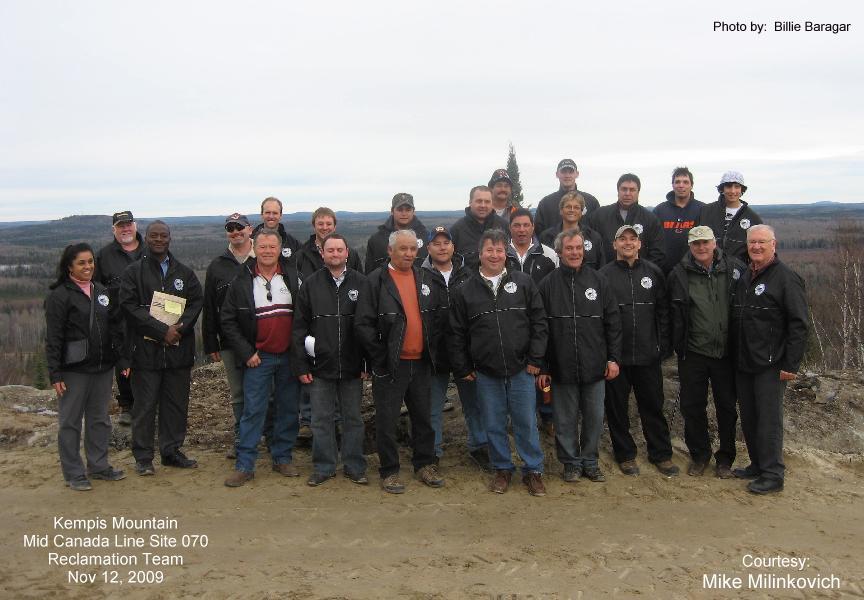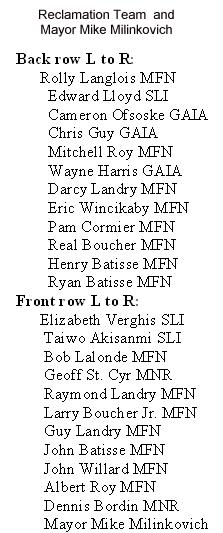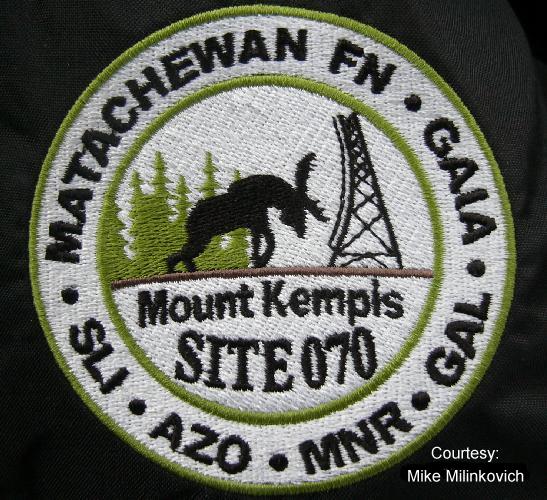Mid Canada Line (MCL) – Tropo Repeater Station 070
Kempis Mountain (Ramore), ON
The Final Chapter for Mid Canada Line Site 070
By: Mike Milinkovich
November 12, 2009 is the day that the final chapter was written about the “Cold War” that began just after WW II between the Soviet Union and the Western allies. I began work at Kempis Mountain in the late 1950’s and participated in the ceremony on November 12th that signalled the final chapter in the history of “Mid-Canada Line site 070” in the Township of Black River-Matheson.
The establishment of the North American Air Defence Command (NORAD) coincided with the flight of Russia’s Sputnik I (the first man-made object shot into space orbit) and the successful launch of the first Soviet Intercontinental Ballistic Missile (ICBM). The Canadian and American government’s agreement to create NORAD to counter a Soviet nuclear-armed bomber threat was reached in August 1957 and formally signed in May 1958.
Subsequently the three early warning radar detection systems built in the late 1950’s, the U.S.-built Distant Early Warning (DEW) Line, the Canadian built and manned Mid-Canada Line (MCL), and the jointly erected Pinetree Line became critical NORAD components.
In 1955-56, Kempis Mountain, also known as Mid-Canada Line site 070 was built. Site 070 was the last link of a chain of Mid-Canada Line communications sites that stretched north to Hudson Bay. Site 070 was not a radar site but a communication site linked to similar sites at site 060 (also called Relay and located 80 miles North of Cochrane), site 050 at Ft. Albany and finally to site 415 located at Cape Henrietta Maria on the western shore of James Bay.
Data that was collected by the Mid-Canada Line Doppler Detection Sites (Radar sites) was transmitted south from site 070 by land line to the “Hole” in North Bay. The “Hole”, as it was called, was the co-located headquarters for the northern region of NORAD. The other NORAD headquarters site was located in the Cheyenne Mountains in Colorado. Together, these two sites controlled North American defences against potential threats from the air by analyzing data and information from the northern radar lines to determine if jets had to be scrambled to meet potential threats from attacking forces.
During the construction of site 070 and during the years it was manned, people from the Township of Black River-Matheson played a big part. The road up Kempis Mountain and the levelling of the site for construction was done primarily by the late Vic Hembruff’s company now called R. J. Lougheed Trucking Ltd. and currently owned by Bob Lindsay. Much of the concrete work and construction was completed by a company called H Á D Construction and owned at the time by the late Ernie Dambrowitz and Floyd Hembruff. Sadly this company no longer exists. Many people from the towns of Holtyre, Matheson, Ramore, Shillington and Val Gagne also worked for years at various occupations at the site.
Unfortunately one of the dangerous legacies left behind at all the sites across Canada including site 070 is an organic chemical compound called “Polychlorinated biphenyl” or as commonly known, PCBs. This chemical was commonly used for many years in various types of electronic equipment installed at all the sites. In addition, tests were conducted to identify Hydrocarbons and metals and when found were removed.
You may ask, “So what’s the big deal?” The big deal is that PCBs are classified as “persistent organic pollutants” meaning PCBs never degrade or disappear but persist in the environment and accumulate in human and animal tissue. The only way to get rid of it from the environment is to remove it and destroy it by various methods at specially designed facilities. PCBs can cause serious health problems in humans and other mammals such as lowering of the immune system, birth defects, health problems such as cancer and diabetes or a failure by males to reproduce.
The team that successfully completed the cleanup operation over a relatively short timeframe began work on site August 26, 2009 and completed the project in November 2009. The team included representatives from the Matachewan First Nation (MFN), SNC-Lavalin Inc. (SLI), Golder Associates Innovative Application (GAIA), an affiliate of GAIA’s called Golder Associates Limited (GAL), AirZOne One (OZO), and the Ministry of Natural Resources (MNR).
By the end of the project the team had removed over 17,000 tons of material from Kempis Mountain. This material was trucked to sites in Quebec and other locations in Ontario for proper disposal. In total 2342 samples of soil, leachate, hydrocarbons, concrete, bedrock, PCB wipe tests for non-porous materials and water were tested for contaminates.
As Mayor, I was honoured to be asked to participate in the closing ceremonies to represent the Township of Black River-Matheson and also from a personal perspective as one of the ‘survivors’ whose site 070 story began over 50 years ago. From 1956 to 1961 it was my privilege to have worked on all three Radar lines; MCL, DEW and Pinetree. I worked in every Province in Canada from the tip of Vancouver Island at Holdberg to Newfoundland and Labrador, in the Northwest Territories and further north above the Arctic Circle on Baffin Island. This experience profoundly cemented my deep love and appreciation of this wonderful country of ours at an early age.
We should all be thankful that the Federal and Provincial governments have agreed to work together to fund the cleanup of this cold war era mess so future generations of Canadians will be protected. In particular the Ontario government’s Ministry of Natural Resources (MNR) and Minister Donna Cansfield should be congratulated for becoming the lead agency in coordinating the cleanup efforts.
I wish them luck and God speed in cleaning up all the other sites in Northern Ontario.
Mike Milinkovich, Mayor
Township of Black River-Matheson



Kempis jacket patch.
